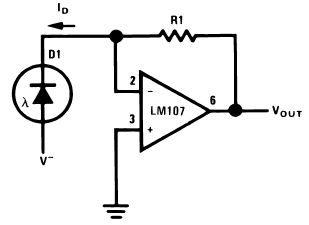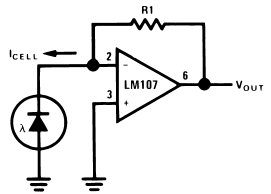circuits
schematics
diagrams
FreeCircuits.net

Photocell Amplifiers
By internum
Amplifiers for photoconductive, photodiode and photovoltaic cells are shown in Figures 1, 2, 3 respectively.

Figure 1. Amplifier for Photoconductive Cell
All photogenerators display some voltage dependence of both speed and linearity. It is obvious that the current through a photoconductive cell will not display strict proportionality to incident light if the cell terminal voltage is allowed to vary with cell conductance. Somewhat less obvious is the fact that photodiode leakage and photovoltaic cell internal losses are also functions of terminal voltage. The current-to-voltage converter neatly sidesteps gross linearity problems by fixing a constant terminal voltage, zero in the case of photovoltaic cells and a fixed bias voltage in the case of photoconductors or photodiodes.


Figure 2. Photodiode Amplifier
Photodetector speed is optimized by operating into a fixed low load impedance. Currently available photovoltaic detectors show response times in the microsecond range at zero load impedance and photoconductors, even though slow, are materially faster at low load resistances.


Figure 3. Photovoltaic Cell Amplifier
The feedback resistance, R1, is dependent on cell sensitivity and should be chosen for either maximum dynamic range or for a desired scale factor. R2 is elective: in the case of photovoltaic cells or of photodiodes, it is not required in the case of photoconductive cells, it should be chosen to minimize bias current error over the operating range.
 6925
6925 ![]() 10 December 2007
10 December 2007
